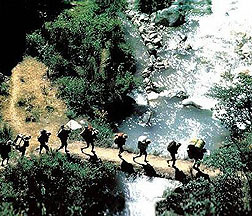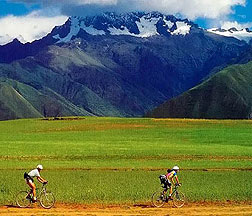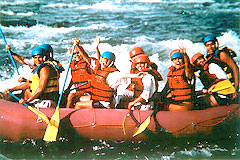Peru is a paradise for adventure and extreme sports enthusiasts of all levels as the country’s diverse geography -- mountains, desert, jungle, and ocean -- offer numerous options for experiencing authentic culture while fulfilling a large appetite for adventure.

Adventure-lovers will find the Andes to be one of the most incredible places for trekking, camping and mountain-climbing. The highlands are riddled with more than 15,000 lakes, snow-capped peaks soaring over 6,000 meters (19,700 feet), the world's deepest canyons, beautiful valleys and picturesque villages. The entire Andean chain offers opportunities for mountaineering, mountain biking, hang gliding, rock climbing, water rafting, surfing, and sport fishing.
Trekking & Mountaineering
Peru features the world's deepest canyons, thundering waterfalls and trails that are so steep they lead into breath-taking gorges. The trails of Peru offer endless possibilities and many ideal combinations for hikers of all levels of experience. In addition, the Peruvian Andes provide an unmatched spot for mountaineering and makes Peru a favorite for mountain climbers from all over the world. A unique concentration of mountains and relatively few mountain climbers, mild weather almost all year-long and easy access to sites that are practically cut off from hectic city life, make Peru one of the most attractive destinations for mountaineers all over the world. Peru’s famous trekking and mountaineering spots include:
- Inca Trail to Machu Picchu - Part of the 23,000 km (approximately 14,000 miles) of roads built by the Incas in South America, this is Peru's most famous trekking route and one of the most spectacular in the Americas. Every year, 25,000 hikers from around the world walk along the extraordinary 43 km of stone-paved road built by the Incas leading to the unassailable citadel of Machu Picchu located in the depth of the Cusco jungle. The journey starts in the village of Qorihuayrachina, at kilometer 88 of the Cusco -Quillabamba railway and takes three or four days of strenuous walking. The route includes an impressive variety of altitudes, climates and ecosystems that range from the high Andean plain to the cloud forest.
Trekkers will cross two high altitude passes (the highest being Warmiwañuska at 4,200 meters above sea level) to culminate the hike with a magical entrance to Machu Picchu through the Inti Punko or Gateway of the Sun. One of the main attractions along the route is the web of ancient settlements built in granite rock by the Incas like Wiñay Wayna and Phuyupatamarca immersed in overpowering natural scenery. Hundreds of species of orchids, multicolored birds and dreamlike landscapes provide the ideal backstage for a route that every hiker should walk at least once.
- Cordillera Blanca - The Cordillera Blanca, or White Mountain, located in the western section of the occidental chain of the North Andes of Peru, between Conococha and Pelagatos on the department of Ancash, is 180 km long. The Cordillera Blanca, characterized by mountain peaks of perennial glaciers, is home to the highest mountains in Peru, with 35 snow-capped mountains. Huascarán, the Huandoy, the Alpamayo and the Pastoruri are among the majestic peaks that rise more the 6,000 meters (19,700 feet) above sea level. The whole area of the White Mountain range is located at 4,000 meters (13,120 feet) above sea level or more and is protected, creating the National Park of Huascarán. The beautiful landscapes of the National Park of Huascarán, with natural paths and old Inca roads, are ideal for walks. Journeys can be for one day or for several weeks, including camping at the end of each day. The ideal season is between April and November. The great natural beauty, rich flora and fauna, majestic snowy mountains, canyons and gulches, as well as archaeological remains and towns of native communities await visitors.
- Colca Valley - Located 180 km (112 miles) north of Arequipa, Colca Valley used to be called the Valley of the Collaguas because it is formed by the river of the same name. The Collaguas were a pre-Inca that flourished in this area and were accomplished artists in textiles and stone carvings. During the colonial period, they worked as bricklayers and "hayllis" composers. The current residents of this valley are heirs of the ancient collaguas crafeets. The valley is enclosed before the canyon and runs from east to west. The cold waters from the Colca River come from the top of the mountains, and on the side banks of the river is beautiful scenery and lots of cultural activity. Where the Colca River runs between the tiny mountain villages of Chivay to Cabanaconde, exists a deep canyon known as the Colca Canyon.
- Huayhuash - The spectacular Cordillera Huayhuash, located south of Cordillera Blanca in the Peruvian Andes, despite being only 40 km (19 miles) long, has become a favorite for both trekking and adventure walks. Many mountaineers consider this 180 km (112 miles) trekking route to be the world's most difficult, longest and most spectacular. The average altitude of the trail is approximately 4,300 meters (14,107 feet). The most direct way to access Cordillera Huayhuash is through the town of Chiquián located at 2,400 meters (7,872 feet) above sea level, the capital of the district of Bolognesi. It can be reached by a road that leads to Huaraz.
- Summits of Arequipa - Arequipa is synonymous with volcanoes, blue skies, and endless plains. Known as the White City for the white volcanic ashlar stone used in its buildings, Arequipa sits at the foot of the western Andes. The city is the starting point for a number of ascents of variable difficulty, all characterized by a rare combination of breath-taking landscapes, easy access, and a significant cultural element. Misti volcano at 5,825 meters (19,110 feet) is the main symbol of Arequipa. More than a climb, going up Misti entails a two-day walk on ofeeten-loose ground up steep slopes. The most popular ascent starts from the city of Arequipa itself and goes on to Tambo Inca and the base camp at Nido de Aguilas (Eagle's Nest) to reach the summit on the second day of ascent. Chachani (6,075 meters, 19,930 feet), the city's other volcano, can be approached along a spectacular gravel road that climbs toward the Pampa de Arrieros. Four hours from Arequipa, the Colca Valley features stunning mountains that have also become popular among mountain climbers.
Mountain Biking
Mountain biking is the fastest-growing sport in Peru, and year-round, thousands of bikers head out on their bicycles down canyons and up trails all over the country. With the exception of the coastal desert and the Amazon plain, practically the entire country is appropriate for mountain biking. However, depending on the degree of difficulty and logistical needs, circuits are divided into three categories: Beginners which have gentle sloping routes, with tough, compact terrain; Experienced which has circuits involving moderate slopes and a certain degree of risk for the cyclist; Experts which has steep slopes, high altitudes and uneven, screen-like terrain, with a high degree of risk.
Peru’s famous mountain biking locations include:

- Pachacamac - Located 31 km (19 miles) south of Lima down the old South Pan-American Highway, this is a favorite spot for bikers. From the old Hacienda San Fernando plantation east of the town of Pachacamac, cyclists will find access to a series of circuits that vary in degree of difficulty and types of terrain: La Chacra, along the route to Cieneguilla, El Manzano, El Cardal, El Chirimoyo El Lúcumo and Las Lomas, among others. The routes are cycled from April to December.
Bikers which to make this route can do it, if they wish, they will be able to combine the adventure with the mystic and culture because in this zone is located the Sanctuary of Pachacamac.
Rock Climbing
Peru features places with superb conditions for open-air rock climbing such as Vichuya in the LurÃn Valley on the central coast of Peru and Canchacalla located at Kilometer 46 on the Central Highway in the RÃmac Valley. Infiernillo, at Kilometer 67 of the same highway, is possibly one of the most accessible and difficult climbing spots in the country. Following the south coast down the Pan-American Highway travelers can find the sedimentary rock formations of Bikini (Kilometer 45), La Tiza (Kilometer 60) and Paracas (Kilometer 250), all of them facing the Pacific Ocean and overlooking breaking waves which add to the exhilaration of the experience. The Andes also feature ideal rock formations such as Cumbemayo, outside Cajamarca; the Tinajani stone formations, in Ayaviri, Puno; the walls of the glacial canyon of Llanganuco, in Ancash; and the stone formations of the Huayllay Sanctuary, in Pasco. In the lower part of the snowy mountains of the Mountain Ranges of Vilcabamba, Vilcanota and Urubamba, numerous rock walls exist, with enormous potential for rock climbing. There rock walls appear almost vertical. Climbing hard rock is possible year round but rainy season, between the months of December to April, add a greater degree of difficulty to the experience.
Water Rafting
Peru features more than a dozen rivers that are each more than 600 km (373 miles) long. The Canete River is without a doubt a favorite amongst rafting enthusiasts. The stretch near the fruit growing region of Lunahuana, features Class II-IV rapids. The rivers feature Class II-III rapids and can be visited from May through October. The Santa River, which winds through the Callejón de Huaylas Valley, in the department of Ancash,splits the Cordillera.

Blanca and Cordillera Negra mountain ranges. The stretch used for rafeeting runs between the towns of Caraz and Yungay and features Class II-III rapids. Water rafting can be done from May to October, making it an ideal complement to a visit to the region. Water rafting can be practiced by anyone, even those without previous experience. Expert guides are available in these regions that provide all the necessary equipment.
Windsurfing
Open air sports such as windsurfing have been gaining followers in recent years. Windsurfers flock to the breezy bays of Paracas (Atenas, Mendieta and Yumaque) as well as certain areas along the north coast such as Pacasmayo, El ParaÃso and Medio Mundo, the most popular spot.
Sand Boarding and Dune-Buggy Rides
Huge dunes up to 250 meters or 820 feet high on the Peruvian coast have been transformed into a sand boarding paradise. These two activities have become popular on the sand dunes near Huacachina, an ideal area to take on the steep sandy slopes of the desert. Miles and miles of endless sand dunes make this an off-road paradise. There is no limit to the excitement that can be found. The most popular sand dunes are located at the Huacachina Oasis in the department of Ica. The sandy wastes of this area gave rise to major pre-Colombian civilizations, leaving traces that have survived the ravages of time and wind erosion. The Huacachina Oasis is a beautiful oasis located at 5 km (3 miles) from Ica city; a beautiful place in the desert with a small lagoon surrounded by sand dunes, palms and huarangos (carob tree) and beautiful houses around the shore.
Sport Fishing
Tuna, drums, flounder, pacific croaker, grunt, sea bass and black marlin are some of the amazing types of fish that make the waters off the coast of Peru a fisherman’s paradise. Peru’s rocky bluffs, sweeping sandy beaches and cold waters teeming with plankton and warm clear currents create the perfect environment for trolling and jigging (known as pinteo fishing in Peru). Trolling is usually done in the deep water off the north coast using artificial bait to reel in tuna, black marline and local species such as a aguijilla, sierra (mackerel), pluma, and perico. Pinteo fishing is done from an anchored boat along the coast of Peru, yielding the same varieties as cliff top fishing with the addition of cuskeel, sea bass, and smooth hounds in the north.
For more information about adventure sports in Peru, call 1-866-661-PERU (in the U.S.) or visit www.peru.info.




